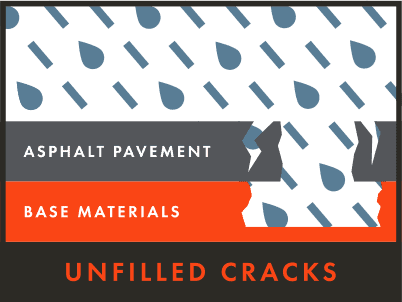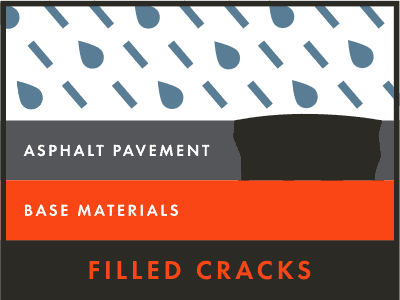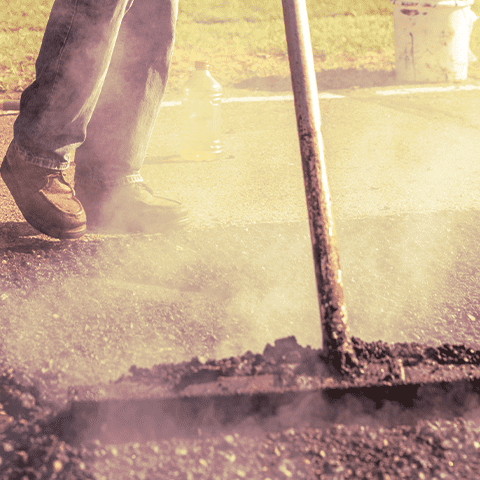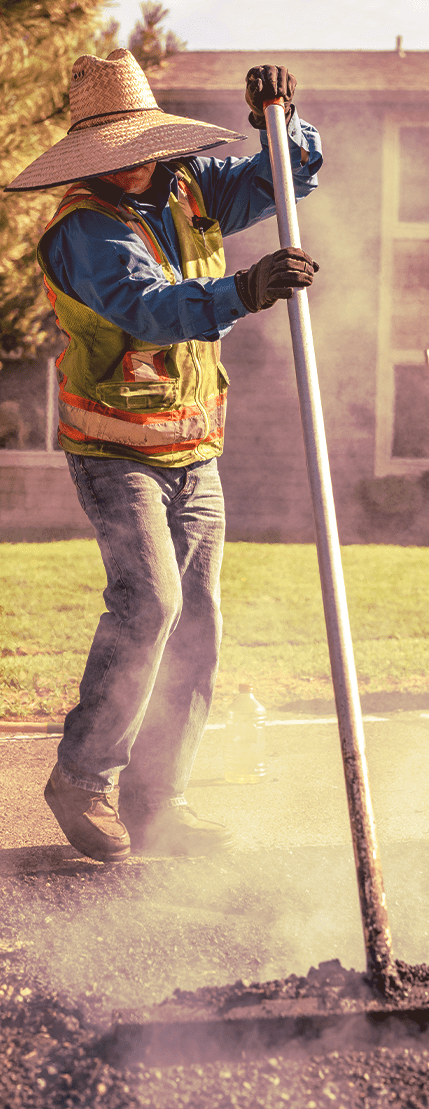Asphalt Repair and Maintenance
Services
Whether your property has cracks, potholes, bumps, or settling, we can help. We understand that your parking lot is crucial to your business and we work efficiently to minimize any disruption to your business.
Proactively addressing asphalt issues before they get too bad can extend the life of your property and save you money. The cost of maintaining a parking lot is far less expensive than replacing it entirely. Our asphalt experts will evaluate your property for free and help you develop a plan that provides the most value to you and your property.


Cracksealing
Crack sealing is one of the most cost-effective
solutions for pavement preservation.
Cracks allow water to penetrate the asphalt accelerating its deterioration.
Asphalt cracks are caused primarily by freeze thaw cycles, moisture, sun, and ground movement. Once moisture penetrates down to the pavement’s subsurface, it softens the asphalt’s subgrade, then freeze/thaw cycles expand the crack. Eventually, the pavement deteriorates around the crack forming potholes, alligator cracking, subsurface failure, and other problems.
Sealing the cracks on a preventative maintenance program, prevents the problem from spreading and helps prolong the life of the pavement.
How Cracksealing Works


The DACS Cracksealing Process
- Thoroughly clean debris from the cracks using wire brushes and commercial blowers.
- Apply a premium rubberized crack sealer that is heated to a liquid, at 400 degrees, and poured into cracks and allowed to cool, sealing the crack and protecting it from water penetration and freeze/thaw damage. The specialized rubber remains pliable in winter temperatures, resisting splitting and further deterioration.
- Seal independent cracks over ¼ inch wide using a hot rubberized material that meets or exceeds all state and federal specifications.
Note: Transition joints, joints between asphalt and concrete are just as important to seal for similar reasons.
Asphalt Patching
Sometimes you need a quick fix. Patching is a temporary fix and it is cost effective, but it may only last months or a few years. We’ll do what we can to make it last as long as possible. Discuss with your DACS paving expert whether patching is the correct solution for your project.
DACS Asphalt Patching Process
- Clean damaged or loose material and dirt from the pothole.
- Apply tack coat to the sides and bottom of the pothole.
- Fill the hole with hot mix asphalt and roll and compact.
Infrared Asphalt Repair
Infrared asphalt repairs are an ideal temporary to intermediate
pavement solution for asphalt areas that have light damage.
Infrared asphalt repairs are an ideal temporary to intermediate pavement solution for asphalt areas that have light damage.

Infrared Patching is also good for minor settlement, surface cracks, bumps, speedbumps, low spots, minor potholes, around manhole covers, and around handicap ramps.
Benefits for Infrared Asphalt Repairs
- They blend the new and old asphalt together by creating a seamless patch that is fused to existing asphalt. This prevents further water penetration.
- IR repairs are flat and uniform.
- You have the option to string numerous infrared patches together to cover a larger lightly damaged area.
- IR repairs are an economical intermediate repair solution.
- Infrared repairs are a more intermediate repair than skin/skim patching and pothole repairs.
The DACS Infrared Asphalt Repair Process
- The repair area is thoroughly cleaned of debris.
- Heat is applied to the area by using our infrared machine that heats approximately a 5x7ft area. There is no flame in direct contact with the existing pavement surface. The machine uses infrared heat to heat up to 2 inches depth of asphalt.
- The area is then scored and new asphalt is mixed in with existing asphalt.
- The edges are tacked and the roller pinches the edges to create a seamless joint with the surrounding asphalt.
- The rest of the patches are rolled or plate compacted..
- The result is a seamless 5×7 patch that is flat and uniform.

Important Notes on Infrared Asphalt Repair
- Infrared asphalt patching has its limitations and cannot correct poor subgrades, it may not prevent reflective or previous cracks deeper than 2 inches from reappearing, it is not a good repair for alligator cracking, it will not fix severely damaged areas.
- Infrared repairs are also not suggested for areas with less than 2” of asphalt depth.
- For these type of repairs, full depth asphalt patching is recommended.
Sealcoating
Sealcoating substantially reduces maintenance costs and
at the same time extends the life of asphalt pavements.
Sealcoating substantially reduces maintenance costs and at the same time extends the life of asphalt pavements.
Sealcoating provides protection and aesthetics to your parking lot. Sealcoating your asphalt pavement slows the deterioration of the asphalt by protecting it against the elements. Water and Sunlight can be harsh on asphalt if it’s not properly protected.
Benefits of Sealcoating
- Slows oxidation and resists water penetration.
- Provides a wearing surface.
- Low cost and high return in regards to pavement preservation.
- Improved appearance.
Sealcoating Considerations
- The cost of sealcoating is a minor expense when compared to the cost of not maintaining the asphalt and having to replace the pavement.
- Sealcoating should be performed every 1-2 years in the Colorado climate.


